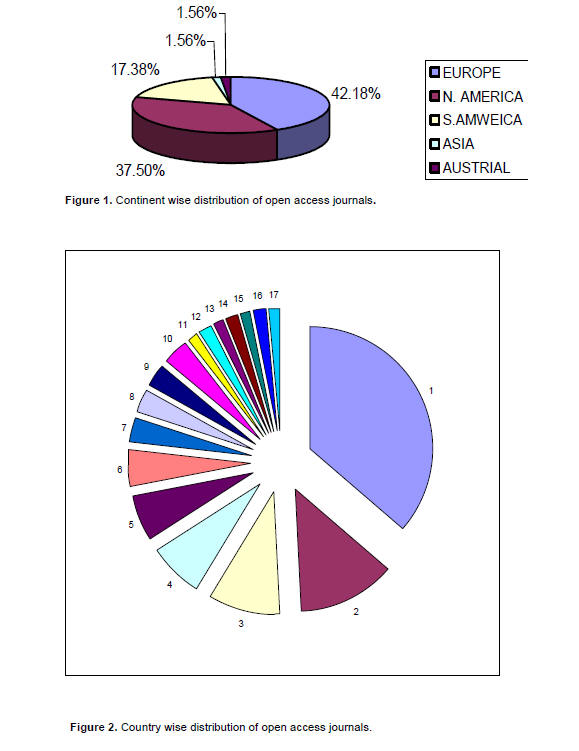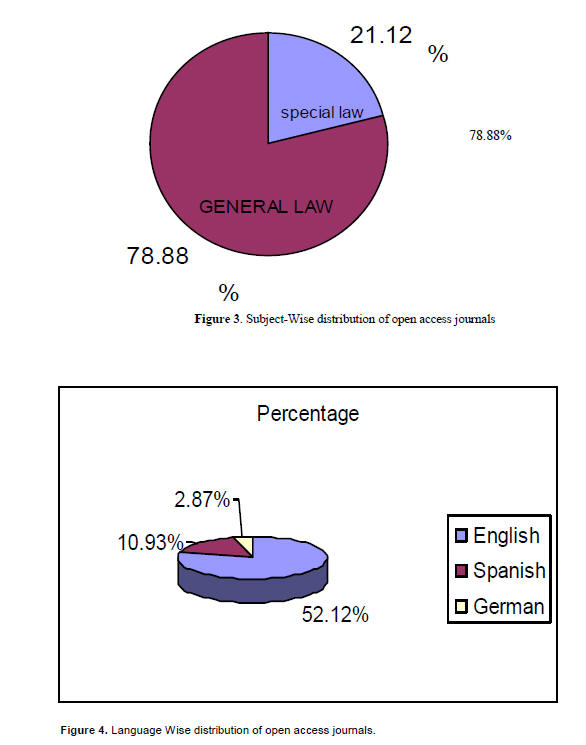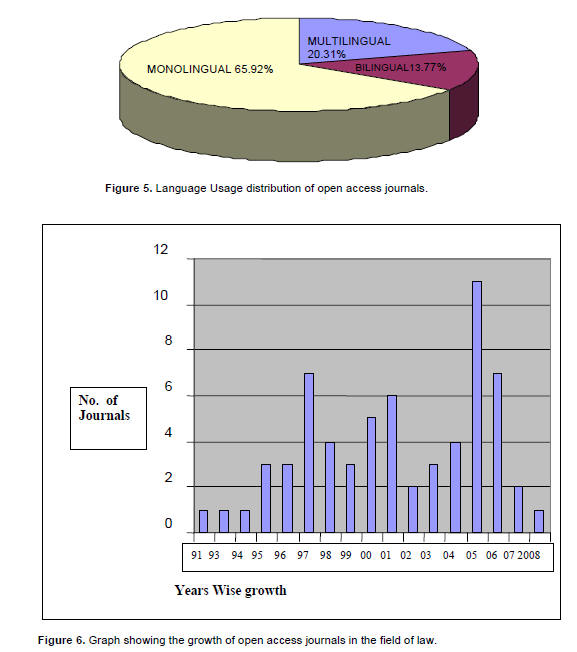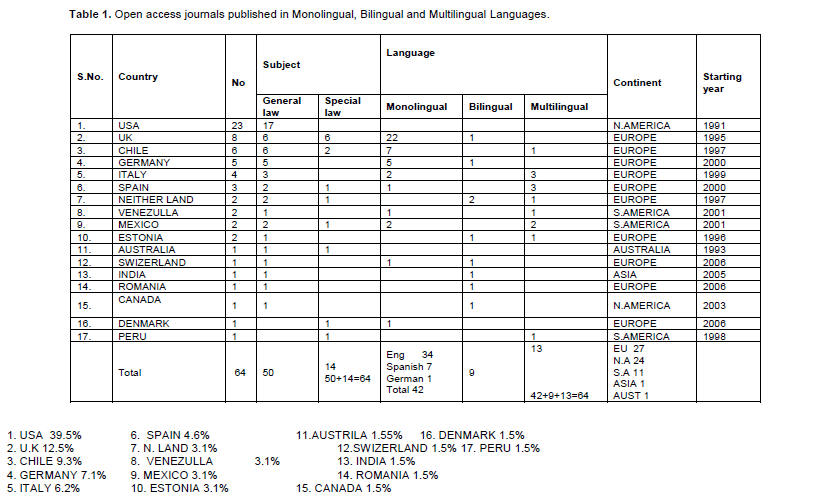|
International Journal of Academic
Library and Information Science Vol. 2(1), pp. 7–13,
January,
ISSN:
2360-7858 ©2014 Academic Research
Journals
Full Length
Research
Open access journals in the field
of law: A global perspective
*Kamran Khan and **Mir Suhail Hamid
*Library assistant Islamic University of Science and Technology,
Kashmir, India.
Corresponding author’s E-mail:
kamran25@rediffmail.com
**Browsing Assistant Islamic University of Science and Technology
Kashmir, India.
E-mail: Suhailmlis@gmail.com
Accepted 20 January, 2014
Open access journals are at a fledgling
stage in the field of law. Only a small percentage of countries are
engaged in open access publishing of law across the globe in the
present digital age .The age in which we moving towards less paper
society and not [paperless] society . And majority of these journals
are published in monolingual language only.
Key words: Open access, sources-law, law journals.
INTRODUCTION
Law is a system of rules, enforced through a set of institutions, used
as an instrument to underpin civil obedience, politics, economics and
society. Law serves as the foremost social mediator in relations between
people. As quoted by Mark in the Rule of Law (2014) he says that
Aristotle said more than two thousand years ago, "The rule of law is
better than that of any individual."
Law consists of a wide variety of separate disciplines. Scholars
investigate the nature of law through many perspectives, including legal
history and philosophy, or social sciences such as economics and
sociology. The study of law raises important and complex issues
concerning equality, fairness, liberty and justice. The central
institutions for interpreting and creating law are the three main
branches of government, namely an impartial judiciary, a democratic
legislature and an accountable executive. According to Wikipedia, the
free encyclopedia to implement and enforce the law and provide services
to the public, a government's bureaucracy, the military and police are
vital. While all these organs of the state are creatures created and
bound by law. An independent legal information system is necessary in
order to inform and support their progress.
Access to information is a fundamental right of a democratic citizenry.
For Democracy to thrive, the general public, lawmakers, law
practitioners, and law scholars alike must have access to the legal
information that describes, explains, critiques, and comprises our laws,
systems of justice, and legal rights.
As the price of scholarly journal subscriptions has increased, and the
costs of mass dissemination have shrunk, scholars and libraries have
proposed alternatives to traditional journal publishing. The citizens of
the 21st century, have not only witnessed the emergence of information
created in digital formats, but have also seen popular and widespread
adoption and disseminated of information via electronic channel which
gave birth to the open access culture.
Today the phrase “open access publishing” has come to describe
disseminating material, usually over the Internet; both free of charge
and free of conventional copyright restrictions on further
dissemination. The most common flavors of open access publishing today
are open access journals, which make their contents available for free
over the Internet, and open access archives, which maintain free
electronic copies of scholarship published in both conventional and
electronic journals. Carroll ( 2006 ) provides four reasons for the use
of open access “ (1) Impact - research in other scholarly disciplines
has shown that articles available on the public Internet are cited more
often than articles not so available; (2) Serving the underserved - many
legal researchers, including prosesand attorneys in small firms, cannot
afford to subscribe to legal periodicals or the commercial databases
that aggregate them; (3) Improving interdisciplinary dialogue - legal
scholarship is becoming more interdisciplinary and therefore of greater
interest to scholars in other fields, who don’t always have access to
Lexis or Westlaw; and (4) Improving international impact and dialogue -
globalization has increased foreign interest in U.S. legal scholarship,
yet scholars in other countries typically lack access to Lexis and
Westlaw.
Nevertheless, the movement for open access has grown far more slowly in
law than in other disciplines, According to Litman (2006), In comparison
with science and medicine, open access legal publishing has grown more
slowly.
SCOPE
The scope of the present study is limited to Open Access journals in the
field of law.The scope is confined to the journals included in DOAJ.
However, Study can not be considered exhaustive because the titles that
are not included in DOAJ are not taken into consideration.
LITERATURE REVIEW
Litman(2006) shows that the open access scholarly publishing in law has
developed an alternative model .Law journal publishing is one of the
easiest cases for open access publishing and open access have shown
viability of the open access business model in a way that its publishing
seems unlikely to have significant impact on the cost of generating and
disseminating research. Arewa( 2006) shows the important role played by
the information in the field of law .He points towards the dominant
players such as Lexis and Westlaw , and the ways in which information
dissemination has changed with the advent of open access legal
information service.
Miller( 2006 ) argues that the open access movement in legal scholarship
fails to address the real problem facing law libraries today. He
suggests that one solution to this problem is for law schools to
redirect some of the resources- intellectual capital, reputation, and
student labor-to publishing legal information for practitioners rather
than legal scholars. Caroll (2006) demonstrates the current situation is
unsatisfactory and argues the society should further embrace the
movement for open access law and allow for the free distribution of
legal.
materials over the internet. He concludes that time is ripe for legal
scholars and scholarly legal periodicals to fully join the movement for
open access to law. Kelly( 2005) has shown there is less push for open
access to legal scholarship than there is for the open access to other
disciplines scholarly output. Hunter ( 2006) made an attempt to explain
how the changes in the modality of publication affect legal scholarship
and economics of open access to legal materials, and its connection to
future where there is infinite content.
METHODOLOGY
DOAJ(Directory of Open Access Journals) identified a total of 64
journals as on 10-09-2008. The complete detail (starting year, country
etc.) about all the journals were recorded. The complete data is
analyzed and presented in various tables and charts.
RESULT AND DISCUSSION
GEOGRAPHICAL DISTRIBUTION
Continent-Wise Distribution: Among all the continents of the world, the
continent Europe covers 42.18% open access journal distribution, next
comes North America with 37.50% followed by South America with17.38
%.Content Asia and Australia shares the lowest spot of 1.56% each.
Figure 1
Country-wise Distribution: The Figure 2 shows the country wise
distribution of open access
journals.The highest percentage of 39.5% open access journals belong to
USA, next comes the United Kingdom with 12.5 % ,followed by Chile 9. 3%
then Germany 7.1%, Italy 6. 2%, Spain 4.6%, Neither land , Venezuela,
Mexico Estonia each possess 3.1% . The lowest percentage of 1. 5% is
possessed by Australia, Switzerland, India, Romania, Canada, Denmark,
and Peru.
Subject-Wise Distribution: In terms of subject analysis the Figure 3
shows that the maximum percentage of 78.87% of open access journals
belong to General law while the percentage of about 21.12% belong to
Special law e.g (sports law) law associated with other fields.
Language Wise Distribution: Open access journals are being published
from each and every corner of the world therefore using different
languages to publish them is natural. So in order to identify different
languages used by OA law journals was conducted. It was found that
English is used by 52.12%, followed by Spanish which forms 10.93 % and
German language forms 2.87%. Figure 4 Language Usage: The open access
journals are being published in monolingual, bilingual and multilingual
languages. The monolingual language forms 65.92%, whereas bilingual
forms 20.13 % and multilingual forms 13.77 %. Figure 5 and Table 1.
Growth of open Access Journals
The first open access journal in the field of law was published in 1991
(Duke environmental law and policy) in USA and the latest open access
journal has been published in 2008(open forensic science journal) from
USA, within a span of 17 years the number of open access journals in the
field of law reached to 64. The highest number OA journals were
published in the year 2005. The year wise growth of open access of law
journals is shown in Figure 6.




CONCLUSION
Today among 195 countries of the world only 17 countries are publishing
open access law journals which shows far less publishing rate of open
access journals in legal system.
It has been found that Open access journals publish information mostly
on general law than that of special law. Most of the open access.
journals are published in monolingual language and more than half of
these journals are in English language. The continent Asia and Australia
are far away in the publishing race of open access journals in the field
of law. During the last seventeen years of open access journal
publication, so for only 64 are OA journals are published in the field
of law which shows a slow rate of publication as compared with other
disciplines who started their open access publication during the same
period. It has been found that the highest numbers of journals were
published in the year 2005.
REFERENCES
Caroll MW (2006). The Movement for Open Access Law,10 Lewis and Clark
Law Review ,p 755-756Vol 10:4 Retrieved October 5, 2008 from
http://www.lclark.edu/org/lclr/objects/LCB_10_4_Carroll.pdf
Litman J (2006). The Economics of Open Access Law Publishing ,10 Lewis
and Clark Law Review p784.Retrieved October 5, 2008 http://www.lclark.edu/org/lclr/objects/LCB_10_4_Litman.pdf.
Litman J (2006). The Economics of Open
Access Law Publishing, 10 Lewis & Clark L. Rev. p 784 (2006),Vol
98:4.Retrieved October 5, 2008
http://www.lclark.edu/org/lclr/objects/LCB_10_4_Litman.pdf.
Arewa OB (2006). Open Access in a Closed Universe. Lexis, West Law
Schools, and Legal Information and the Legal Information Market, Lewis
and Law Review Vol 10:4 p797
Milles JG (2006). Redefining Open Access for the Legal Information
Market, Law Library Journal vol 98:4 p 619
Caroll MW (2006). the Movement for Open Access Law,10 Lewis and Clark
Law Review ,p 741Vol 10:4.Retrieved October 5, 2008 .Available at
http://www.lclark.edu/org/lclr/objects/LCB_10_4_Carroll.pdf
Hunter D (2006 ). Open Access to Infinite Content or in Praise of Law
Review, Portland vol 10:4 p 761 The Rule Of Law by Doctor Mark Cooray
Available at http://www.ourcivilisation.com/cooray/btof/chap180.htm
Retrived on 12/01/2014http://en.wikipedia.org/wiki/Law Retrived on
12/01/2014
http://www.doaj.org/search?source={"query":{"filtered":{"query":{"query_string":{"query":"LAW%20JOURNALS","default_operator":"AND"}},"filter":{"bool":{"must":[{"ter
m":{"_type":"journal"}}]}}}}}#.Ut
Retrived on 12/01/2014
Submitted: January 1, 2014
Accepted: January 20, 2014
All the contents of this
journal, except where otherwise noted, is licensed under a Creative
Commons Attribution License
|




